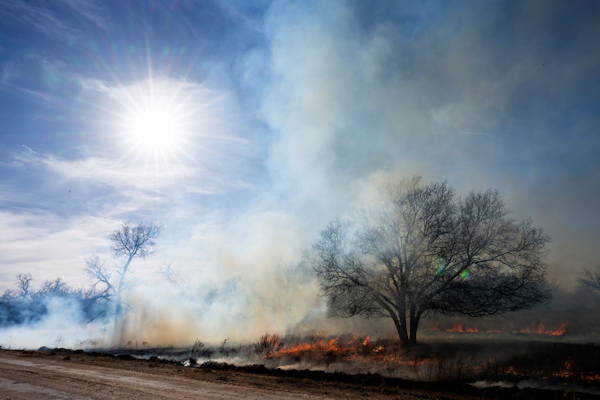SEJournal Online is the digital news magazine of the Society of Environmental Journalists. Learn more about SEJournal Online, including submission, subscription and advertising information.
 |
 |
| Much of the worst damage from wildfires could be averted or lessened by preparedness. Above, strong winds in recent weeks have caused fire to spread across the Texas Panhandle region. Photo: Texas A&M Forest Service. |
TipSheet: Wildfire Preparedness Is a Story Worth Telling — Before ‘Fire Season’
By Joseph A. Davis
Wildfire season is starting.
Well, to be honest, it never really ended.
Anyway, it’s going to get worse. Are you prepared? Is your audience? Your town or county?
Wildfire preparedness is a great story for many environmental journalists — especially those who want to localize or regionalize a story that too often becomes a climate disaster. And those who hope to make it less of a disaster.
It’s important for both
journalists and their audiences
to realize that wildfire presents
a different face in different places.
It’s important for both journalists and their audiences to realize that wildfire presents a different face in different places.
The Texas wildfire complex which began in late February with the Smokehouse Creek Fire was, in fact, right on schedule. While many Texas wildfires cluster later in the summer, the Panhandle season typically sees them start in March.
Why it matters
Wildfires can kill people, consume their homes and destroy people’s lives.
Much of the worst damage could be averted or lessened by preparedness. The exact risks vary a lot by place. Getting prepared for grass fires or brush fires can be very different than for forest fires.
Bear in mind that preparedness for journalists is a bit different than preparedness for residents. Your “go bag” might contain a radio, batteries, credentials, maps, masks, food, laptop, etc.
Story ideas
- What can homeowners in your area do to their land (especially the land around their houses) to lower the risk of destruction to structures? How many have done it? Who is encouraging and supporting these efforts?
- What zoning and building code provisions in your area may apply to wildfire risk? Are there any requirements to make houses and buildings more fire-resistant? Are there any provisions discouraging people from building in fire-prone areas?
- If a catastrophic wildfire were bearing down rapidly on your area, how would people evacuate? How many roads are available? How many ways out? Are there chokepoints and bottlenecks? Is there transportation for people who don’t have cars?
- Does your area have a reunification center for families that have been separated in a disaster? How has this gone in any previous disasters?
- Do families have their own plans for checking in during/after a fire or disaster? Do they know they can get help via the Red Cross, FEMA, Google or Facebook?
- What provisions has your area made for evacuating the most vulnerable people and structures during wildfires or other disasters? Older people? Nursing homes? Schools? Day care facilities? Migrant workers? Homeless people? Prisons?
- Do people know where the nearest emergency shelters are in case they need to evacuate?
- Have people planned for their pets in case of an evacuation? Do local shelters take pets?
- What are the wildfire plans of local public safety agencies (police, fire, etc.)?
- What sort of notification system would authorities in your area use in the event of a wildfire evacuation?
Reporting resources
- State forest and fire agencies: These outfits do much of the actual fire fighting. Find forestry agencies here. Find state fire agencies here.
- FEMA: The Federal Emergency Management Agency helps with wildfires. Check out their preparedness toolkit. Also see Ready.gov.
- American Red Cross: A key disaster assistance agency. See its wildfire preparedness checklist and its advice on wildfire safety.
- National Weather Service: This is one of the agencies that generates and publishes alerts and warnings about wildfire conditions, along with other resources. Start here.
- Emergency Alert System: The national system is a multi-agency and multimedia vehicle to push alerts for all kinds of emergencies. It’s really several systems. Start here. What you probably want is a system that looks at alerts for your area and notifies you on your smartphone.
- National Interagency Fire Center: NIFC is a good place to find updated and relevant information about existing fires, as well as future ones. It has preparedness and predictive information.
[Editor’s Note: For more from SEJournal on wildfires, check out our Topics on the Beat page, which includes more than a dozen and a half articles from recent issues, plus wildfire headlines from EJToday.]
Joseph A. Davis is a freelance writer/editor in Washington, D.C. who has been writing about the environment since 1976. He writes SEJournal Online's TipSheet, Reporter's Toolbox and Issue Backgrounder, and curates SEJ's weekday news headlines service EJToday and @EJTodayNews. Davis also directs SEJ's Freedom of Information Project and writes the WatchDog opinion column.
* From the weekly news magazine SEJournal Online, Vol. 9, No. 12. Content from each new issue of SEJournal Online is available to the public via the SEJournal Online main page. Subscribe to the e-newsletter here. And see past issues of the SEJournal archived here.











 Advertisement
Advertisement 



